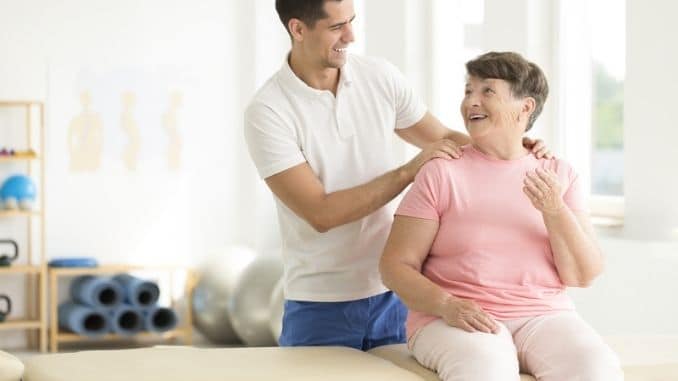A stroke occurs when blood flow to the brain is blocked, damaging areas that control movement, speech, and memory. Survivors often face muscle weakness, difficulty walking, poor balance, and trouble speaking.
Beyond physical struggles, the emotional toll—frustration, fear, or loss of independence—can overwhelm patients and caregivers. The good news: recovery continues beyond the hospital with the help of stroke rehabilitation exercises designed to rebuild movement and function safely at home.
With consistent stroke recovery exercises and guidance from physical and occupational therapists, people can rebuild strength, restore motor function, and regain confidence. These stroke rehabilitation exercises focus on improving mobility, coordination, and strength while retraining the brain to perform everyday movements more effectively.
Leg Exercises
1. Seated Marching
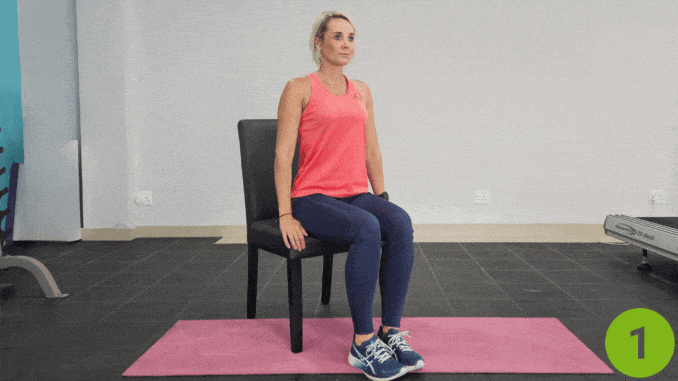
- Begin in an upright sitting position with your feet hip-width apart, maintaining good alignment with your head, shoulders, and hips.
- Place your arms at your sides.
- Engage your core.
- Raise one knee, then put it down, followed by your opposite knee in an alternating movement like you are marching but not moving in your place.
- Return to the starting position and repeat the movement.
2. Ankle Circles
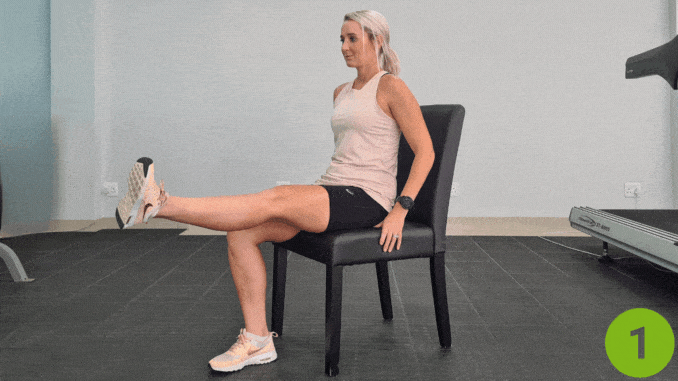
- Begin in an upright sitting position on a chair with your feet flat on the floor, maintaining good alignment with your head, shoulders, and hips.
- Place your hands on the sides of the chair for support.
- Engage your core.
- Extend one leg straight out in front of your body.
- Slowly rotate your ankle in a circular motion, moving clockwise for several repetitions.
- Reverse the direction and rotate counterclockwise.
- Keep the movement controlled and smooth.
- Relax and return to the starting position.
- Repeat the movement on the opposite side.
- Complete the movement for 3 sets of 5–10 circles in each direction per side.
3. Heel Slides
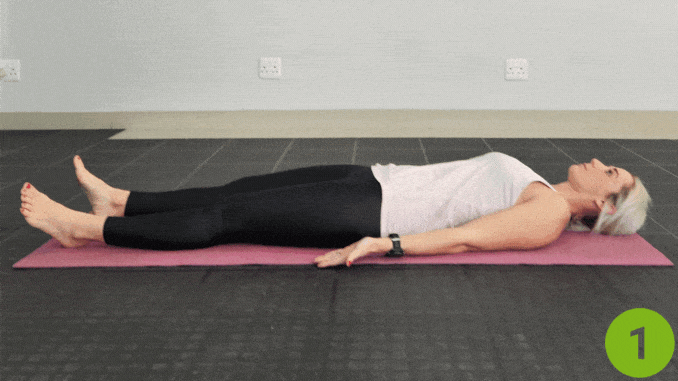
- Lie on your back on the floor or a mat with your legs extended, maintaining good alignment with your head, shoulders, hips, and legs. Place your arms at your sides for support.
- Engage your core.
- Slowly bend one knee, sliding your heel along the floor toward your glutes.
- Pause briefly, then straighten your leg by sliding your heel back down to return to the starting position.
- Repeat the movement on the opposite side.
- Complete the movement for 3 sets of 10 repetitions on each side.
Body/Upper Body Exercises
4. Shoulder Shrugs
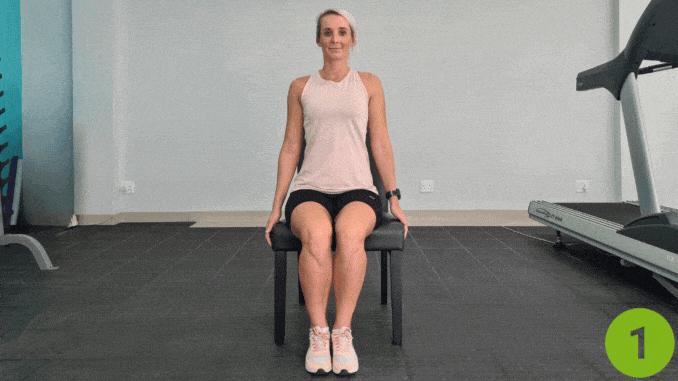
- Begin in an upright sitting position on a chair with your feet flat on the floor, maintaining good alignment with your head, shoulders, and hips.
- Place your arms at your sides with your hands resting comfortably.
- Engage your core.
- Slowly lift both shoulders upward toward your ears, squeezing at the top.
- Hold for a brief moment, then slowly lower your shoulders back down to the starting position. Relax and repeat the movement.
- Complete the movement for 3 sets of 10 repetitions.
5. Arm Raises
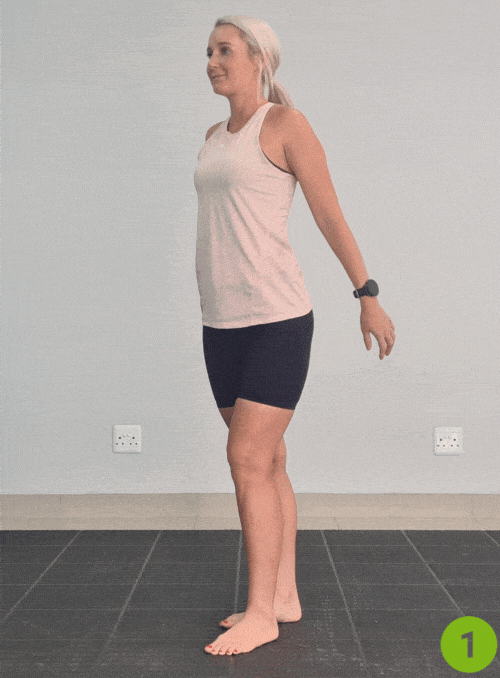
- Begin in an upright standing position with your feet hip-width apart, maintaining good alignment with your head, shoulders, hips, and legs.
- Let your arms rest comfortably at your sides.
- Engage your core.
- Slowly raise both arms forward and upward overhead until they are fully extended.
- Pause briefly at the top, then gently lower your arms back down to the starting position.
- Perform the movement in a controlled manner, avoiding swinging.
- Complete the movement for 3 sets of 10–12 repetitions.
Hand Exercises
6. Finger Tapping
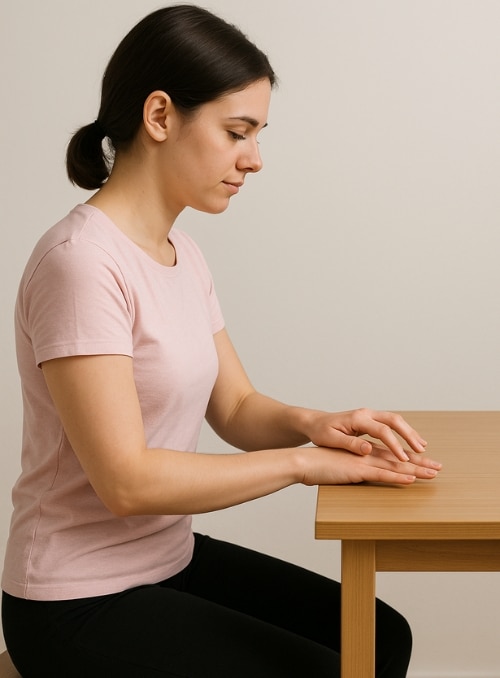
- Begin in an upright sitting position at a table.
- Place your hand flat on the surface, maintaining good alignment with your head, shoulders, and hips.
- Engage your core.
- Slowly tap each fingertip to your thumb in sequence, starting from your index finger to your little finger.
- Continue tapping forward and backward in a smooth, controlled manner.
- Complete the movement for 10 cycles per hand.
7. Wrist Flex and Extend

- Begin in an upright sitting position at a table.
- Rest your forearm on the surface with your wrist and hand hanging off the edge.
- Engage your core.
- Slowly bend your wrist upward toward the ceiling, then lower it downward toward the floor in a controlled manner.
- Avoid jerky movements.
- Complete the movement for 2–3 sets of 10 repetitions on each side.
8. Grip Strengthening
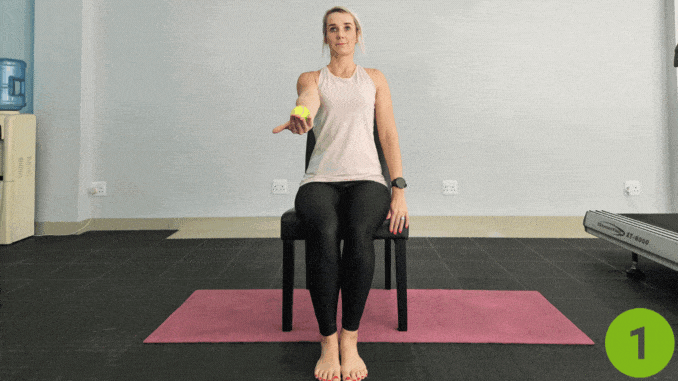
- Begin in an upright sitting position on a chair with your feet flat on the floor, maintaining good alignment with your head, shoulders, and hips.
- Hold a small ball (such as a stress ball or tennis ball) in one hand.
- Engage your core.
- Slowly squeeze the ball as firmly as you can, holding the squeeze for 2–3 seconds.
- Then, relax and release the pressure.
- Repeat the movement for 10–15 repetitions.
- Switch hands and repeat the exercise on the opposite side.
- Complete 2–3 sets per hand.
Completing these movements regularly helps retrain coordination, restore fine motor control, and strengthen weak muscles. Consistency with these Stroke Rehabilitation Exercises is key to improving daily function and promoting long-term recovery.
According to Dr. Steven C. Cramer, MD, a neurologist and stroke rehabilitation expert at UC Irvine, stroke recovery requires high-intensity, repetitive practice to help the brain rewire itself. He explains:
“We’re trying to rewire the brain … if I handed you a French horn and asked you to play, you’d need to work on it every day, an hour a day, for weeks, but people aren’t getting the equivalent of that when it comes to stroke rehabilitation.”
How Common is Stroke?
Every year, about 500,000 new strokes occur in the U.S. [1]
- Stroke is one of the top three causes of death, taking about 150,000 lives each year.
- Around 3 million people in the U.S are living after a stroke.
- Sadly, two out of three stroke survivors are left with some king of long-term disability.
The good news; better treatment for high blood pressure and better emergency care level helped lower stroke deaths over the last 50 years.
Symptoms and Signs of Stroke
Anterior (front) circulation strokes [2]
- Weakness on one affected side of the body.
- Numbness or loss of feeling on the affected limb, or ignoring that side.
- Slurred speech (dysarthria).
- Trouble speaking, understanding, reading and writing (aphasia).
- Vision problems such as losing the same half vision in both eyes, blindness in one eye or ignoring part of the visual field.
Posterior (back) circulation strokes
- Loss of the same half vision in both eyes.
- Double vision or eyes not moving properly together.
- Feeling sick and vomiting.
- Poor coordination or trunk rotation issues leading to unsteadiness.
- Weakness or loss of sensation on one or both sides of the body.
Other general signs
- Trouble swallowing (dysphagia).
- Loss of bladder or bowel control (incontinence).
- Fainting or loss of consciousness.
Why Exercise Matters After a Stroke
Stroke is a serious health problem [3] worldwide. It can cause long-term disability. Rehabilitation (recovery treatment after a stroke) is a very important part of care. Incorporating structured stroke rehabilitation exercises can significantly enhance recovery and improve overall physical performance.
After a stroke, many people assume recovery stops after leaving the hospital. The truth is your brain has an incredible ability to adapt and heal—a process called neuroplasticity. This means that with the right stroke recovery exercises, the brain can “rewire” itself, helping new pathways take over the functions that were damaged in the affected arm, affected leg, or affected hand.
Rehabilitation exercises play a key role in this process. They:
- Restore movement by retraining muscles and coordination.
- Reduce stiffness that can build up when joints and muscles aren’t used regularly.
- Prevent complications such as muscle loss, poor circulation, or even additional falls.
- Improve independence, making daily tasks like standing, dressing, and walking safer and easier.
Recovery may feel slow at times, but remember—small, consistent steps add up. Each repetition signals to the brain and body that they’re working together again. Over time, those signals grow stronger, leading to real progress and a renewed sense of confidence.
Engaging in regular exercise is one of the best things you can do while recovering from stroke. Exercise requires patience and persistence, but whether you are doing simple exercises for the affected limb or more advanced exercise programs, you will build endurance, reduce limited mobility, and protect against heart disease.
Conclusion
Stroke recovery takes time, but regular stroke rehabilitation exercises can restore strength, improve mobility, and build confidence. Each small step supports the brain’s ability to heal and adapt.
Research shows that if people focused on just 5 essential lifestyle factor—it would prevent more than half of the annual deaths from cardiovascular disease. Want to learn what those simple lifestyle changes are? Check out 14-Day Heart Health Quick Start Program now!
Frequently Asked Questions
What is the best way to recover from a stroke?
The best stroke recovery exercises are safe, repetitive, and tailored to each patient’s needs. They focus on rebuilding strength, balance, and walking ability. Arm exercises like wrist flexion and hand squeezes restore fine motor skills, while lower-body moves such as seated marching and weight shifting strengthen the legs and prevent hip fractures.
Balance drills and trunk rotations improve coordination, and guided aerobic exercises like walking enhance heart health and energy. Studies show that combining strength, balance, and aerobic training is the most effective way to restore motor function after a stroke.
How long is recovery after a stroke?
Stroke recovery works best with a structured, therapist-guided exercise plan that starts gently and increases gradually. Functional tasks like reaching, standing, and walking improve independence, while using the affected side restores strength and joint movement. Family support helps motivation, and consistent exercise boosts bone density, muscle tone, and motor skills—even long after a stroke. Rehabilitation also supports emotional health and prevents future complications.
What is important about 72 hours after a stroke?
Stroke recovery time varies widely—some improve within weeks, others over months or years. The fastest progress usually happens in the first three to six months, but steady improvement can continue beyond that with regular exercise.
Ongoing strength, balance, and walking exercises help maintain muscle, bone health, and mobility. With patience and guidance from a physical therapist, recovery can continue even years after a stroke.

